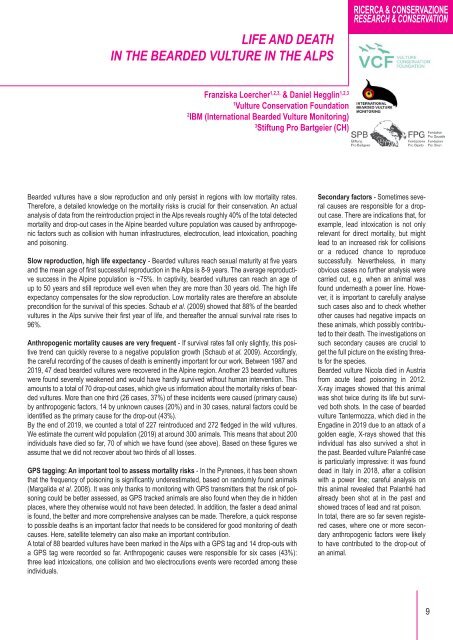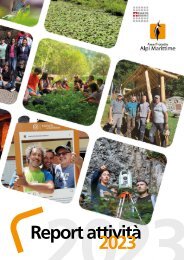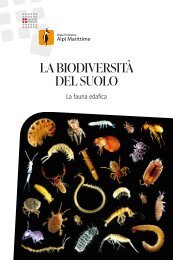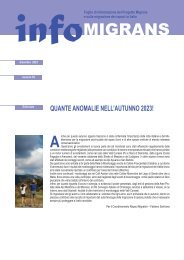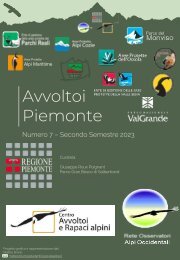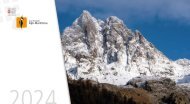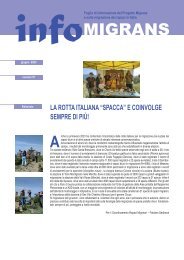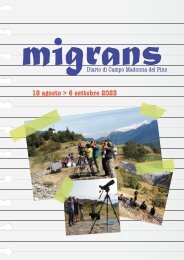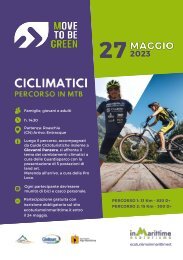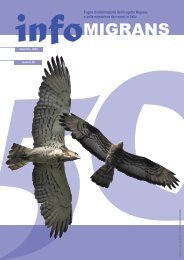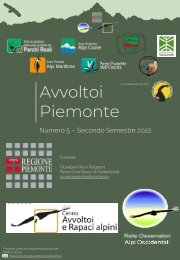infoGIPETO n.37 |dicembre 2020
Periodico d'informazione sul progetto di reintroduzione del gipeto.
Periodico d'informazione sul progetto di reintroduzione del gipeto.
You also want an ePaper? Increase the reach of your titles
YUMPU automatically turns print PDFs into web optimized ePapers that Google loves.
LIFE AND DEATH<br />
IN THE BEARDED VULTURE IN THE ALPS<br />
RICERCA & CONSERVAZIONE<br />
RESEARCH & CONSERVATION<br />
Franziska Loercher 1,2,3, & Daniel Hegglin 1,2,3<br />
1<br />
Vulture Conservation Foundation<br />
2<br />
IBM (International Bearded Vulture Monitoring)<br />
3<br />
Stiftung Pro Bartgeier (CH)<br />
Bearded vultures have a slow reproduction and only persist in regions with low mortality rates.<br />
Therefore, a detailed knowledge on the mortality risks is crucial for their conservation. An actual<br />
analysis of data from the reintroduction project in the Alps reveals roughly 40% of the total detected<br />
mortality and drop-out cases in the Alpine bearded vulture population was caused by anthropogenic<br />
factors such as collision with human infrastructures, electrocution, lead intoxication, poaching<br />
and poisoning.<br />
Slow reproduction, high life expectancy - Bearded vultures reach sexual maturity at five years<br />
and the mean age of first successful reproduction in the Alps is 8-9 years. The average reproductive<br />
success in the Alpine population is ~75%. In captivity, bearded vultures can reach an age of<br />
up to 50 years and still reproduce well even when they are more than 30 years old. The high life<br />
expectancy compensates for the slow reproduction. Low mortality rates are therefore an absolute<br />
precondition for the survival of this species. Schaub et al. (2009) showed that 88% of the bearded<br />
vultures in the Alps survive their first year of life, and thereafter the annual survival rate rises to<br />
96%.<br />
Anthropogenic mortality causes are very frequent - If survival rates fall only slightly, this positive<br />
trend can quickly reverse to a negative population growth (Schaub et al. 2009). Accordingly,<br />
the careful recording of the causes of death is eminently important for our work. Between 1987 and<br />
2019, 47 dead bearded vultures were recovered in the Alpine region. Another 23 bearded vultures<br />
were found severely weakened and would have hardly survived without human intervention. This<br />
amounts to a total of 70 drop-out cases, which give us information about the mortality risks of bearded<br />
vultures. More than one third (26 cases, 37%) of these incidents were caused (primary cause)<br />
by anthropogenic factors, 14 by unknown causes (20%) and in 30 cases, natural factors could be<br />
identified as the primary cause for the drop-out (43%).<br />
By the end of 2019, we counted a total of 227 reintroduced and 272 fledged in the wild vultures.<br />
We estimate the current wild population (2019) at around 300 animals. This means that about 200<br />
individuals have died so far, 70 of which we have found (see above). Based on these figures we<br />
assume that we did not recover about two thirds of all losses.<br />
GPS tagging: An important tool to assess mortality risks - In the Pyrenees, it has been shown<br />
that the frequency of poisoning is significantly underestimated, based on randomly found animals<br />
(Margalida et al. 2008). It was only thanks to monitoring with GPS transmitters that the risk of poisoning<br />
could be better assessed, as GPS tracked animals are also found when they die in hidden<br />
places, where they otherwise would not have been detected. In addition, the faster a dead animal<br />
is found, the better and more comprehensive analyses can be made. Therefore, a quick response<br />
to possible deaths is an important factor that needs to be considered for good monitoring of death<br />
causes. Here, satellite telemetry can also make an important contribution.<br />
A total of 88 bearded vultures have been marked in the Alps with a GPS tag and 14 drop-outs with<br />
a GPS tag were recorded so far. Anthropogenic causes were responsible for six cases (43%):<br />
three lead intoxications, one collision and two electrocutions events were recorded among these<br />
individuals.<br />
Secondary factors - Sometimes several<br />
causes are responsible for a dropout<br />
case. There are indications that, for<br />
example, lead intoxication is not only<br />
relevant for direct mortality, but might<br />
lead to an increased risk for collisions<br />
or a reduced chance to reproduce<br />
successfully. Nevertheless, in many<br />
obvious cases no further analysis were<br />
carried out, e.g. when an animal was<br />
found underneath a power line. However,<br />
it is important to carefully analyse<br />
such cases also and to check whether<br />
other causes had negative impacts on<br />
these animals, which possibly contributed<br />
to their death. The investigations on<br />
such secondary causes are crucial to<br />
get the full picture on the existing threats<br />
for the species.<br />
Bearded vulture Nicola died in Austria<br />
from acute lead poisoning in 2012.<br />
X-ray images showed that this animal<br />
was shot twice during its life but survived<br />
both shots. In the case of bearded<br />
vulture Tantermozza, which died in the<br />
Engadine in 2019 due to an attack of a<br />
golden eagle, X-rays showed that this<br />
individual has also survived a shot in<br />
the past. Bearded vulture Palanfré case<br />
is particularly impressive: it was found<br />
dead in Italy in 2018, after a collision<br />
with a power line; careful analysis on<br />
this animal revealed that Palanfré had<br />
already been shot at in the past and<br />
showed traces of lead and rat poison.<br />
In total, there are so far seven registered<br />
cases, where one or more secondary<br />
anthropogenic factors were likely<br />
to have contributed to the drop-out of<br />
an animal.<br />
9


